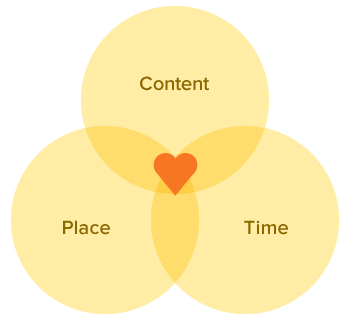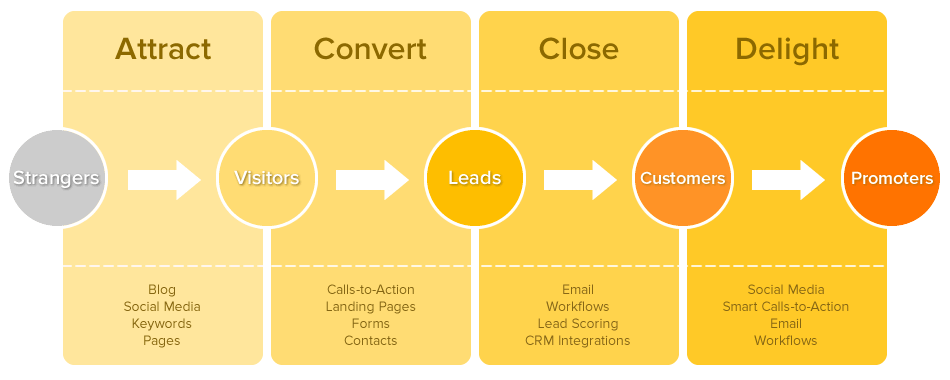Inbound Marketing Methodology
The best way to turn strangers into customers and promoters of your business.
The proven methodology for the digital age
Since 2006 inbound marketing has been the most effective marketing method for doing business online. Instead of the old outbound marketing methods of buying ads, buying email lists, and praying for leads, inbound marketing focuses on creating quality content that pulls people toward your company and product, where they naturally want to be. By aligning the content you publish with your customer’s interests, you naturally attract inbound traffic that you can then convert, close, and delight over time.
How to interpret the graphic
Along the top are the four marketing actions (Attract, Convert, Close, Delight) inbound marketers must take in order to obtain visitors, leads, and customers. Along the bottom are the tools marketers use to accomplish these actions. (Note the tools are listed under the marketing action where they first come into play, but that’s not the only place they’re applicable! Several tools, like email, can be essential in several stages of the methodology.)
What is Inbound Marketing?
Sharing is caring and inbound marketing is about creating and sharing content with the world. By creating content specifically designed to appeal to your dream customers, inbound marketing attracts qualified prospects to your business and keeps them coming back for more.
Major themes:
- Content Creation - You create targeted content that answers your customer's basic questions and needs, and you share that content far and wide.
- Lifecycle Marketing - You recognize that people go through stages as they interact with your company, and that each stage requires different marketing actions.
- Personalization - As you learn more about your leads over time, you can better personalize your messages to their specific needs.
- Multi-channel - Inbound marketing is multi-channel by nature because it approaches people where they are, in the channel where they want to interact with you.
- Integration - Your publishing and analytics tools all work together like a well-oiled machine, allowing you to focus on publishing the right content in the right place at the right time.
Make marketing people love.
By publishing the right content in the right place at the right time, your marketing becomes relevant and helpful to your customers, not interruptive. Now that’s marketing people can love.

The Four Marketing Actions

Attract
We don’t want just any traffic to our site, we want the right traffic. We want the people who are most likely to become leads, and, ultimately, happy customers. Who are the “right” people? Our ideal customers, also known as our buyer personas. Buyer personas are holistic ideals of what your customers are really like, inside and out. Personas encompass the goals, challenges, pain points, common objections to products and services, as well as personal and demographic information shared among all members of that particular customer type. Your personas are the people around whom your whole business is built.
Some of the most important tools to attract the right users to your site are:
- Blogging - Inbound marketing starts with blogging. A blog is the single best way to attract new visitors to your website. In order to get found by the right prospective customers, you must create educational content that speaks to them and answers their questions.
- Social Media - You must share remarkable content and valuable information on the social web, engage with your prospects, and put a human face on your brand. Interact on the networks where your ideal buyers spend their time.
- Keywords - Your customers begin their buying process online, usually by using a search engine to find something they have questions about. So you need to make sure you’re appearing prominently when they search. To get there, you need to carefully, analytically pick keywords, optimize your pages, create content, and build links around the terms your ideal buyers are searching for.
- Pages - You must optimize your website to appeal to and speak with your ideal buyers. Transform your website into a beacon of helpful content to entice the right strangers to visit your pages.

Convert
Once you’ve got visitors to your site, the next step is to convert those visitors into leads by gathering their contact information. At the very least, you’ll need their email addresses. Contact information is the most valuable currency there is to the online marketer. In order for your visitors to offer up that currency willingly, you need to offer them something in return. That “payment” comes in the form of content, like ebooks, whitepapers, or tip sheets -- whatever information would be interesting and valuable to each of your personas.
Some of the most important tools in converting visitors to leads include:
- Calls-to-Action - Calls-to-action are buttons or links that encourage your visitors to take action, like “Download a Whitepaper” or “Attend a Webinar.” If you don’t have enough calls-to-action or your calls-to-action aren’t enticing enough, you won’t generate any leads.
- Landing Pages - When a website visitor clicks on a call-to-action, they should then be sent to a landing page. A landing page is where the offer in the call-to-action is fulfilled, and where the prospect submits information that your sales team can use to begin a conversation with them. When website visitors fill out forms on landing pages, they typically become leads.
- Forms - In order for visitors to become leads, they must fill out a form and submit their information. Optimize your form to make this step of the conversion process as easy as possible.
- Contacts - Keep track of the leads you're converting in a centralized marketing database. Having all your data in one place helps you make sense out of every interaction you’ve had with your contacts -- be it through email, a landing page, social media, or otherwise -- and how to optimize your future interactions to more effectively attract, convert, close, and delight your buyer personas.

Close
You’re on the right track. You’ve attracted the right visitors and converted the right leads, but now you need to transform those leads into customers. How can you most effectively accomplish this feat? Certain marketing tools can be used at this stage to make sure you’re closing the right leads at the right times.
Closing tools include:
- Lead Scoring - You’ve got contacts in your system, but how do you know which ones are ready to speak to your sales team? Using a numerical representation of the sales-readiness of a lead takes the guesswork out of the process.
- Email - What do you do if a visitor clicks on your call to action, fills out a landing page, or downloads your whitepaper, but still isn’t ready to become a customer? A series of emails focused on useful, relevant content can build trust with a prospect and help them become more ready to buy.
- Marketing Automation - This process involves creating email marketing and lead nurturing tailored to the needs and lifecycle stage of each lead. For example, if a visitor downloaded a whitepaper on a certain topic from you in the past, you might want to send that lead a series of related emails. But if they follow you on Twitter and visited certain pages on your website, you might want to change the messaging to reflect those different interests.
- Closed-loop Reporting - How do you know which marketing efforts are bringing in the best leads? Is your sales team effectively closing those best leads into customers? Integration with your Customer Relationship Management (CRM) system allows you to analyze just how well your marketing and sales teams are playing together.

Delight
Inbound marketing is all about providing remarkable content to our users, whether they be visitors, leads, or existing customers. Just because someone has already written you a check doesn’t mean you can forget about them. Inbound marketers continue to engage with, delight, and (hopefully) upsell their current customer base into happy promoters of the companies and products they love.
Tools used to delight customers include:
- Smart Calls-to-Action - These present different users with offers that change based on buyer persona and lifecycle stage.
- Social Media - Using various social platforms gives you the opportunity to provide real-time customer service.
- Email and Marketing Automation - Providing your existing customers with remarkable content can help them achieve their own goals, as well as introduce new products and features that might be of interest to them.
A New Methodology
The new Inbound Marketing Methodology covers each and every step taken, tool used, and lifecycle stage travelled through on the road from stranger to customer. It empowers marketers to attract visitors, convert leads, close customers, and delight promoters. The new methodology acknowledges that inbound marketing doesn’t just happen, you do it. And you do it using tools and applications that help you create and deliver content that will appeal to precisely the right people (your buyer personas) in the right places (channels) at just the right times (lifecycle stages).
